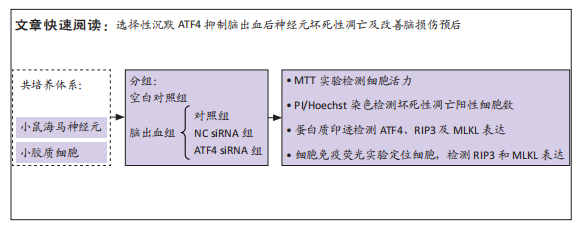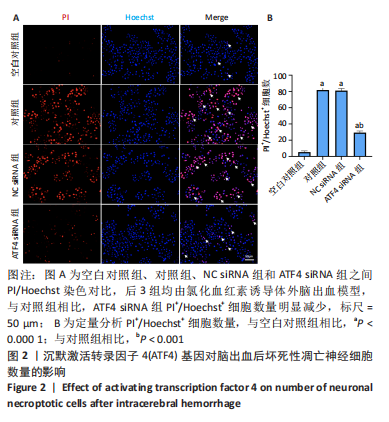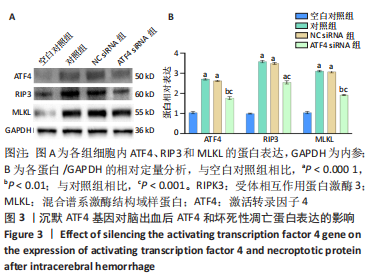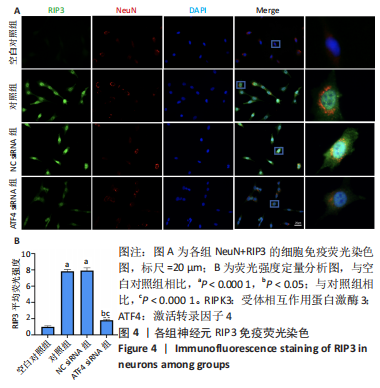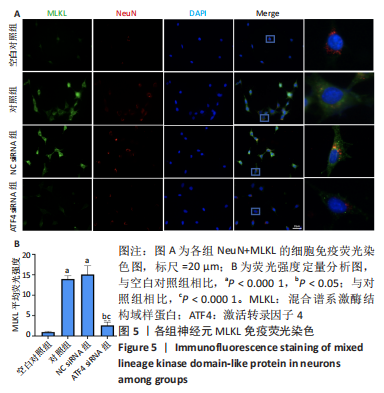[1] SHETH KN. Spontaneous Intracerebral Hemorrhage. N Engl J Med. 2022;387(17):1589-1596.
[2] KASE CS, HANLEY DF. Intracerebral Hemorrhage: Advances in Emergency Care. Neurol Clin. 2021;39(2):405-418.
[3] KIRSHNER H, SCHRAG M. Management of Intracerebral Hemorrhage: Update and Future Therapies. Curr Neurol Neurosci Rep. 2021; 21(10):57.
[4] XUE M, YONG VW. Neuroinflammation in intracerebral haemorrhage: immunotherapies with potential for translation. Lancet Neurol. 2020; 19(12):1023-1032.
[5] FRANK D, VINCE JE. Pyroptosis versus necroptosis: similarities, differences, and crosstalk. Cell Death Differ. 2019;26(1):99-114.
[6] NAYAK D, ROTH TL, MCGAVERN DB. Microglia development and function. Annu Rev Immunol. 2014;32:367-402.
[7] LI X, ZHANG M, HUANG X, et al. Ubiquitination of RIPK1 regulates its activation mediated by TNFR1 and TLRs signaling in distinct manners. Nat Commun. 2020;11(1):6364.
[8] YUAN J, AMIN P, OFENGEIM D. Necroptosis and RIPK1-mediated neuroinflammation in CNS diseases. Nat Rev Neurosci. 2019;20(1):19-33.
[9] CHEN AQ, FANG Z, CHEN XL, et al. Microglia-derived TNF-α mediates endothelial necroptosis aggravating blood brain-barrier disruption after ischemic stroke. Cell Death Dis. 2019;10(7):487.
[10] DENG XX, LI SS, SUN FY. Necrostatin-1 Prevents Necroptosis in Brains after Ischemic Stroke via Inhibition of RIPK1-Mediated RIPK3/MLKL Signaling. Aging Dis. 2019;10(4):807-817.
[11] LI J, ZHANG J, ZHANG Y, et al. TRAF2 protects against cerebral ischemia-induced brain injury by suppressing necroptosis. Cell Death Dis. 2019; 10(5):328.
[12] KRUKOWSKI K, NOLAN A, FRIAS ES, et al. Small molecule cognitive enhancer reverses age-related memory decline in mice. Elife. 2020;9: e62048.
[13] YANG T, ZHANG Y, CHEN L, et al. The potential roles of ATF family in the treatment of Alzheimer’s disease. Biomed Pharmacother. 2023; 161:114544.
[14] NAKAGAWA T, OHTA K. Quercetin Regulates the Integrated Stress Response to Improve Memory. Int J Mol Sci. 2019;20(11):2761.
[15] KEERTHIGA R, PEI DS, FU A. Mitochondrial dysfunction, UPRmt signaling, and targeted therapy in metastasis tumor. Cell Biosci. 2021; 11(1):186.
[16] WU X, LUO J, LIU H, et al. Recombinant adiponectin peptide promotes neuronal survival after intracerebral haemorrhage by suppressing mitochondrial and ATF4-CHOP apoptosis pathways in diabetic mice via Smad3 signalling inhibition. Cell Prolif. 2020;53(2):e12759.
[17] KARUPPAGOUNDER SS, ALIM I, KHIM SJ, et al. Therapeutic targeting of oxygen-sensing prolyl hydroxylases abrogates ATF4-dependent neuronal death and improves outcomes after brain hemorrhage in several rodent models. Sci Transl Med. 2016;8(328):328ra29.
[18] ZHANG J, ZHANG P, MENG C, et al. The PERK Pathway Plays a Neuroprotective Role During the Early Phase of Secondary Brain Injury Induced by Experimental Intracerebral Hemorrhage. Acta Neurochir Suppl. 2020;127:105-119.
[19] JHA RM, KOCHANEK PM, SIMARD JM. Pathophysiology and treatment of cerebral edema in traumatic brain injury. Neuropharmacology. 2019;145(Pt B):230-246.
[20] CHEN S, PENG J, SHERCHAN P, et al. TREM2 activation attenuates neuroinflammation and neuronal apoptosis via PI3K/Akt pathway after intracerebral hemorrhage in mice. J Neuroinflammation. 2020; 17(1):168.
[21] YIN K, LU H, ZHANG Y, et al. Secondary brain injury after polystyrene microplastic-induced intracerebral hemorrhage is associated with inflammation and pyroptosis. Chem Biol Interact. 2022;367:110180.
[22] PENG C, FU X, WANG K, et al. Dauricine alleviated secondary brain injury after intracerebral hemorrhage by upregulating GPX4 expression and inhibiting ferroptosis of nerve cells. Eur J Pharmacol. 2022;914:174461.
[23] BOBINGER T, BURKARDT P, B HUTTNER H, et al. Programmed Cell Death after Intracerebral Hemorrhage. Curr Neuropharmacol. 2018; 16(9):1267-1281.
[24] ZHANG Y, KHAN S, LIU Y, et al. Modes of Brain Cell Death Following Intracerebral Hemorrhage. Front Cell Neurosci. 2022;16:799753.
[25] ROBINSON N, GANESAN R, HEGEDŰS C, et al. Programmed necrotic cell death of macrophages: Focus on pyroptosis, necroptosis, and parthanatos. Redox Biol. 2019;26:101239.
[26] TONG X, TANG R, XIAO M, et al. Targeting cell death pathways for cancer therapy: recent developments in necroptosis, pyroptosis, ferroptosis, and cuproptosis research. J Hematol Oncol. 2022;15(1):174.
[27] HUAN Y, WU XQ, CHEN T, et al. Necroptosis plays a crucial role in the exacerbation of retinal injury after blunt ocular trauma. Neural Regen Res. 2023;18(4):922-928.
[28] HSU SK, LI CY, LIN IL, et al. Inflammation-related pyroptosis, a novel programmed cell death pathway, and its crosstalk with immune therapy in cancer treatment. Theranostics. 2021;11(18):8813-8835.
[29] COLONNA M, BUTOVSKY O. Microglia Function in the Central Nervous System During Health and Neurodegeneration. Annu Rev Immunol. 2017;35:441-468.
[30] SUBHRAMANYAM CS, WANG C, HU Q, et al. Microglia-mediated neuroinflammation in neurodegenerative diseases. Semin Cell Dev Biol. 2019;94:112-120.
[31] JIN X, LIU MY, ZHANG DF, et al. Baicalin mitigates cognitive impairment and protects neurons from microglia-mediated neuroinflammation via suppressing NLRP3 inflammasomes and TLR4/NF-κB signaling pathway. CNS Neurosci Ther. 2019;25(5):575-590.
[32] CORNELL J, SALINAS S, HUANG HY, et al. Microglia regulation of synaptic plasticity and learning and memory. Neural Regen Res. 2022;17(4): 705-716.
[33] UMPIERRE AD, WU LJ. How microglia sense and regulate neuronal activity. Glia. 2021;69(7):1637-1653.
[34] ALMEIDA LM, PINHO BR, DUCHEN MR, et al. The PERKs of mitochondria protection during stress: insights for PERK modulation in neurodegenerative and metabolic diseases. Biol Rev Camb Philos Soc. 2022;97(5):1737-1748.
[35] MENG C, ZHANG J, DANG B, et al. PERK Pathway Activation Promotes Intracerebral Hemorrhage Induced Secondary Brain Injury by Inducing Neuronal Apoptosis Both in Vivo and in Vitro. Front Neurosci. 2018; 12:111.
[36] FONT-BELMONTE E, UGIDOS IF, SANTOS-GALDIANO M, et al. Post-ischemic salubrinal administration reduces necroptosis in a rat model of global cerebral ischemia. J Neurochem. 2019;151(6):777-794.
[37] ESTORNES Y, AGUILETA MA, DUBUISSON C, et al. RIPK1 promotes death receptor-independent caspase-8-mediated apoptosis under unresolved ER stress conditions. Cell Death Dis. 2015;6(6):e1798.
[38] JIANG H, WANG C, ZHANG A, et al. ATF4 protects against sorafenib-induced cardiotoxicity by suppressing ferroptosis. Biomed Pharmacother. 2022;153:113280.
[39] WANG X, ZHANG G, DASGUPTA S, et al. ATF4 Protects the Heart From Failure by Antagonizing Oxidative Stress. Circ Res. 2022;131(1):91-105.
[40] SZEWCZYK MM, LUCIANI GM, VU V, et al. PRMT5 regulates ATF4 transcript splicing and oxidative stress response. Redox Biol. 2022;51: 102282.
|
